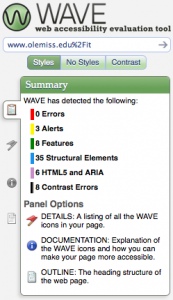If you are a campus webmaster or the head of a department with a website, I encourage you to review the policy on Accessibility of Technology Services. We have a self-imposed deadline coming up on September 1 to have all of our “official Web pages” pass the error checks in the WAVE: Web Accessibility Evaluation Tool. Any sites that do not meet this minimum standard of accessibility may be disabled from public viewing until the problems have been corrected.
Go ahead and take a couple of seconds to see if your webpage passes the WAVE test without any errors. I’ll wait.
…
Done? How many errors did you find? None? Great, you passed! If you found some errors, did you explore further by clicking on the flag icon to see what they were about? Is it missing some “alt” attributes for your images? Or maybe your form fields are missing a label or two? Once you know what parts of the webpage are raising those red flags, you should be able to update the page to fix them. A few times through the scanning/correcting process for each of your webpages should ensure that your website is at least minimally accessible.
What do we mean when we say a website is “minimally accessible?” While the ideal would be to have our sites be universally accessible to all visitors, an automated script can’t determine that. Beyond the minimal level of accessibility that a script can evaluate, it takes a “real live” person using a site to determine how accessible it is. Functional navigation and color choices contribute to a site’s level of accessibility. Broken links and unclear content–problems that confound all visitors–would also be considered obstacles to accessibility. So our goal, at the very least, is to measure all our websites against the WAVE test standards. Once a site passes that, then we can begin building on that success to improve it in more subjective ways.
In addition to the WAVE test, we also pay for a service called Siteimprove that crawls parts of the university’s site each week searching out broken links, misspelled words, and potential accessibility issues. These reports are more in-depth than the WAVE test, and they often point out obvious things that we webmasters sometimes overlook: the use of deprecated HTML tags and attributes which should be replaced with more accessible features; the use of tables for formatting when they should only be used for tabular data; etc. It’s very tempting to think that a webpage is okay as long as it looks okay. Without the proper underlying structure, though, it won’t communicate effectively to everyone visiting it. If your site isn’t benefiting from the SiteImprove reports, please contact me and let me add it to the list.
Finally, in preparation for the September 1 deadline, I’ll be offering two hands-on workshops Friday morning, August 16, for anyone who would like to scan their sites and see what changes will be needed to pass the WAVE test. This is also a good opportunity to ask other questions you may have about Web accessibility. Please contact me at webmaster@olemiss.edu to let me know if you are interested in attending either the 9:00 or 10:00 workshop. And if you manage your website using a laptop, bring it with you and we can see about making corrections right then.
No one wants to avoid shutting down websites more than I do. It’s difficult to do, and it reflects badly on the affected departments and on the university as a whole. But if we are serious about providing a broadly accessible Web presence, then it would be better not to post anything online rather than posting content that is incorrect, incoherent, or inaccessible. September 1 is coming soon.
